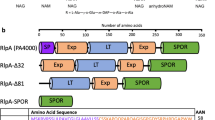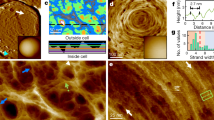Abstract
Bacteria have developed a number of trans-envelope systems to transport molecules or assemble organelles across bacterial envelopes. However, bacterial envelopes contain a rigid netlike peptidoglycan structure that protects cells from osmotic lysis. Trans-envelope systems thus must interact with the peptidoglycan barrier to generate gaps or anchor structures to the peptidoglycan scaffold. Here we describe methods to use in vivo cross-linking and in vitro co-sedimentation to study protein–peptidoglycan interactions in Gram-negative bacteria. In particular, we address important considerations to ensure the specificity of the interactions in question.
Similar content being viewed by others
References
Höltje JV (1998) Growth of the stress-bearing and shape-maintaining murein sacculus of Escherichia coli. Microbiol Mol Biol Rev 62:181–203
Dijkstra AJ, Keck W (1996) Peptidoglycan as a barrier to transenvelope transport. J Bacteriol 178:5555–5562
Scheurwater EM, Burrows LL (2011) Maintaining network security: how macromolecular structures cross the peptidoglycan layer. FEMS Microbiol Lett 318:1–9
Howard SP, Gebhart C, Langen GR, Li G, Strozen TG (2006) Interactions between peptidoglycan and the ExeAB complex during assembly of the type II secretin of Aeromonas hydrophila. Mol Microbiol 59:1062–1072
Glauner B (1988) Separation and quantification of muropeptides with high-performance liquid chromatography. Anal Biochem 172:451–464
Li G, Howard SP (2010) ExeA binds to peptidoglycan and forms a multimer for assembly of the type II secretion apparatus of Aeromonas hydrophila. Mol Microbiol 76:772–781
Hoijer MA, Melief MJ, van Helden-Meeuwsen CG, Eulderink F, Hazenberg MP (1995) Detection of muramic acid in a carbohydrate fraction of human spleen. Infect Immun 63:1652–1657
Typas A, Banzhaf M, Gross CA, Vollmer W (2011) From the regulation of peptidoglycan synthesis to bacterial growth and morphology. Nat Rev Microbiol 10:123–136
Clarke AJ (1993) Compositional analysis of peptidoglycan by high-performance anion-exchange chromatography. Anal Biochem 212:344–350
Sulfuric Acid (2015) The Columbia Encyclopedia, 6th edn. http:// www.encyclopedia.com. Accessed 26 Jan 2016
Author information
Authors and Affiliations
Corresponding author
Editor information
Editors and Affiliations
Rights and permissions
Copyright information
© 2017 Springer Science+Business Media LLC
About this protocol
Cite this protocol
Li, G., Peter Howard, S. (2017). In Vivo and In Vitro Protein–Peptidoglycan Interactions. In: Journet, L., Cascales, E. (eds) Bacterial Protein Secretion Systems. Methods in Molecular Biology, vol 1615. Humana Press, New York, NY. https://doi.org/10.1007/978-1-4939-7033-9_11
Download citation
DOI: https://doi.org/10.1007/978-1-4939-7033-9_11
Published:
Publisher Name: Humana Press, New York, NY
Print ISBN: 978-1-4939-7031-5
Online ISBN: 978-1-4939-7033-9
eBook Packages: Springer Protocols




